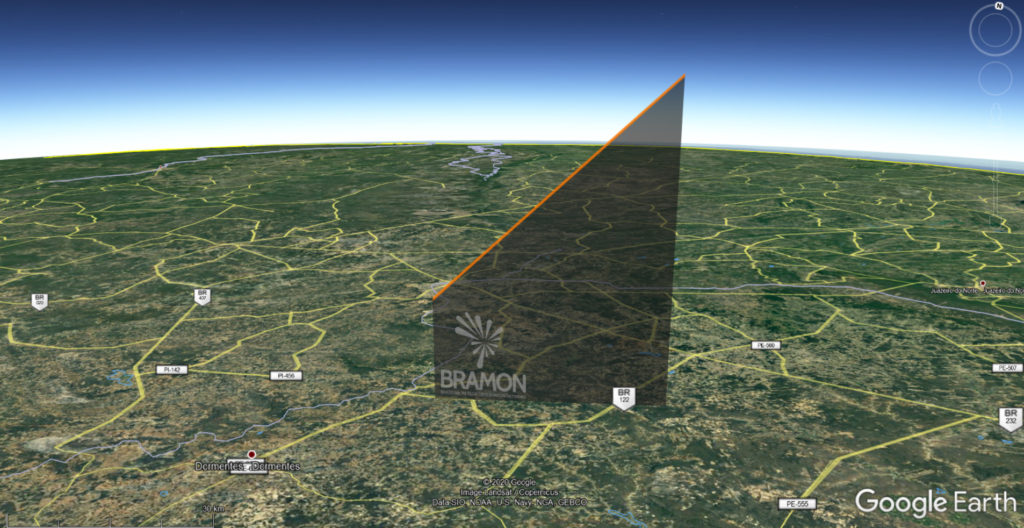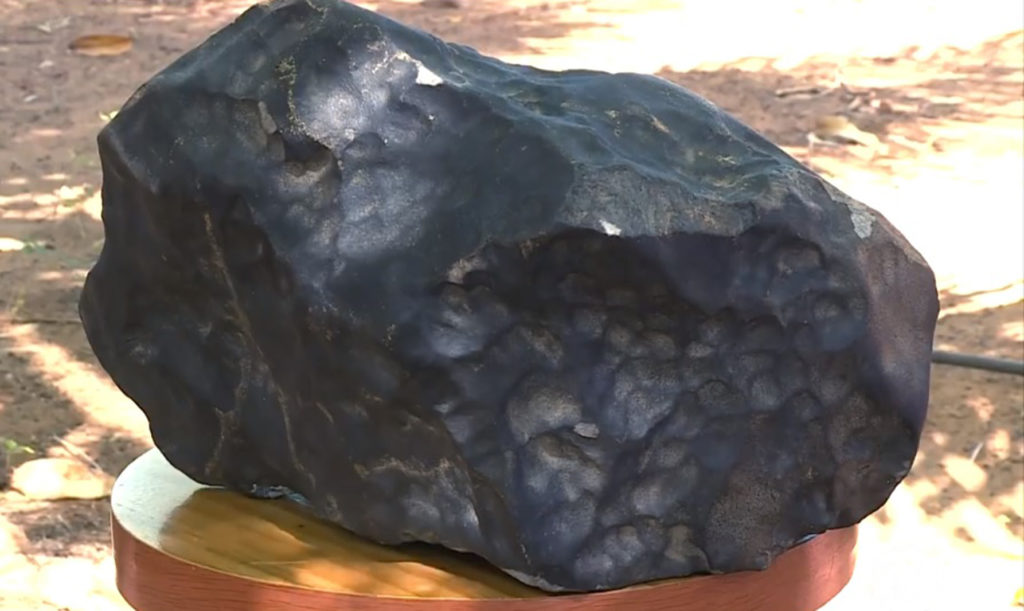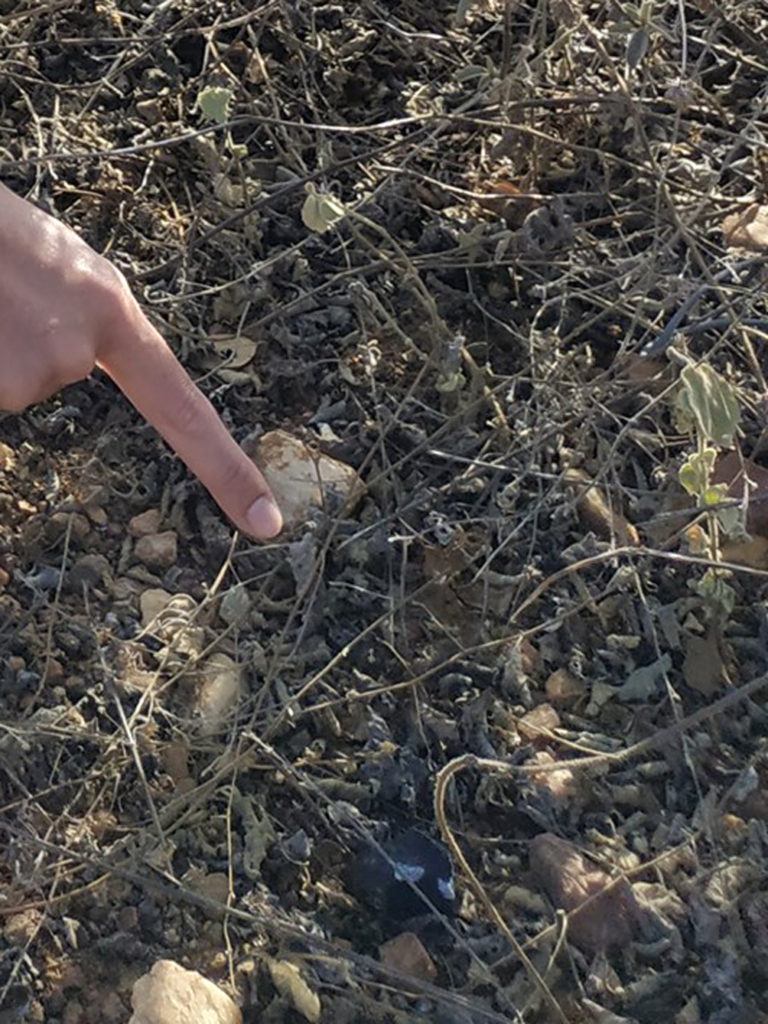Santa Filomena
SANTA FILOMENA meteorite fall ( >80 kg, H5-6, S4) in and around Santa Filomena, Pernambuco in Brazil at ~10:18:17.32-39 a.m. BRT (13.18:17 UTC) on 19 August 2020
The 38.2-kilogram main mass of Santa Filomena

The nearly fully fusion-crusted and regmaglypted 38.2-kilogram Santa Filomena mass (~42 x ~31 cm) in the evening of 28 August 2020. Photo: M. Farmer

The regmaglypted 38.238-kilogram Santa Filomena mass. Photo: M. Farmer

The impact pit of the 38.2-kilogram mass which fell somewhere about 9 kilometres west or southwest of Santa Filomena. Photo: G1
The 2.821-kilogram mass of Santa Filomena

The 2.821-kilogram Santa Filomena mass. Photo: M. Farmer

The impact location of the 2.8-kilogram mass. Photo: Raymond Borges
Last update: 12 April 2023
In the evening of 28 August it became known that a regmaglypted 38.2-kilogram mass (~42 x ~31 cm) had been found in a field in the morning of the same day, about “7 km from Santa Filomena on the Pernambuco-Piaui state border”. A representative of the owner presented the meteorite to Maria Elizabeth Zucolotto, curator of the Meteorite collection at the National Museum of the Federal University of Rio de Janeiro (UFRJ), at the city’s hotel and gas station. The name of the finder, Mario Ramos, as well as the exact find location on his farm, west or southwest of Santa Filomena, were not revealed. Mario Ramos, the owner of the meteorite, had heard the bolide’s detonation boom inside his home but did not know what is was at the time. A few days later a friend who was in the open fields when the meteorite fell told him that he had heard a sound as if something had hit the ground not far away. Mario Ramos decided to search for meteorites in the area. On his fourth day of searching at dawn the owner started to search his property to locate the meteorite. He had already been searching for about three hours and was already looking for the best way back to where he had parked his motorcycle when at around 8.30 a.m. he found the impact pit with the meteorite mass which had entirely sunk into the ground on impact. The finder dug it out and carried it on his shoulders through the Caatinga to his motorcycle at a road about 2 kilometers away from the fall location. Then he took it home and showed it to his wife. Because of the material value of the meteorite the owner’s family were afraid for some time. They feared that the meteorite could be stolen. Eventually, the meteorite was stored in a safe, away from their property. Mr. Ramos intended to sell the meteorite for ‘a fair price’ but was not in a hurry to negotiate the price. He was unwilling to donate the meteorite to the National Museum of the Federal University of Rio de Janeiro and instead wanted to sell it to anyone who would pay the highest price. In January 2021 the meteorite was put up for sale on the internet and eventually sold and exported. The owner and his wife apparently intend to turn the fall site into a publicly accessible small park with a memorial or milestone for visitors. Another beautiful cone-shaped, regmaglypted and flight-oriented 2.821-kg meteorite mass fell on the roof of a bar destroying some of its roof tiles. Apparently, the mass first hit the southern wall of the upper floor of a house (no. 226), then bounced off, hit the roof of Dona Socorro’s house (number 225) in the Rua Genesio Marinho Falcao and rolled off the roof. Apparently, it was found by Dona Socorro’s son Genilson. The fall site on the bar is at location 8°09’45.6″S 40°36’50.6″W in the Rua Genesio Marinho Falcao in the city centre of Santa Filomena, near Praça da Matriz. According to witnesses it was still hot when touched. The ordinary chondrite (H-chondrite ?) with an approximate diameter of ~15 to ~17 centimeters was acquired to be curated and presented in the rebuilt National Museum of Brazil in the future. Another mass of about a few hundred grams was found near the fall location on the bar. Several other smaller masses have been found east of Santa Filomena. One meteorite was found at location 8°09’45.0″S 40°36’09.0″W, 1.29 kilometers east of the fall location of the 2.8-kilogram mass. Two cousins, bricklayer assistant Emanuel Carvalho Cruz and IT technician Laurent Douglas de Lima Cruz, worked at a construction site of a house near location 8° 9’59.39″S, 40°35’59.16″W in the urban area Vila Caramari, about 1640 meters east to east-southeast of the fall location of the 2.8-kilogram mass near Praça da Matriz, when they heard an explosion in the sky and thought it was an airplane which had exploded. Then they looked at the sky and saw the dust trail. They didn’t care until about one minute later three meteorites (212, 171 and 120 grams) fell very close to them within a perimeter of about 50 meters. Laurent Douglas de Lima Cruz says one ~120-gram meteorite impacted the ground only about 30 cm from where he was working. He didn’t see it fall but only heard an impact noise, saw a little dust cloud and then saw the meteorite on the ground. Before the meteorites fell the cousins had heard a noise similar to the sound of a drone. Several meteorite specimens have apparently been found within a perimeter of about 100 meters around this location. Another ~ 498(670?)-gram meteorite fell through the roof of farmer Janete Kerliane Pereira’s house (no. 5) at location ~ 8°9’37.03″S, 40°36’13.25″W in the Cohab neighborhood. It broke into at least two bigger fragments on impact and landed on a bed Pereira had slept in not long before. Her son first thought classmates had thrown a stone and went to his uncle who told him that it wasn’t an ordinary stone. It was still hot when it was touched. Her brother Cleidivan Silva reported about the incident in social media. The meteorite fragments were sold on 26 August. A farmer called Sebastião found one bigger and two smaller fragments of a 1.4-kilogram specimen which according to him broke when impacting a tree. The 20-year old student and civil firefighter Edimar Da Costa Rodrigues was at his brother’s house when he heard the bolide’s detonation sound and thought it was a tire of a truck which had burst, then saw the spiral-shaped funnel of the dust trail in the sky. Then he went home and saw a photo of the meteorite in the local social media. He recognised the depicted location near the church at Praça da Matriz in the city centre, went there and picked up the 164.32-gram specimen about 10 to 15 minutes after the detonation boom. The meteorite was not hot when touched. Apparently, no other resident had had the courage to touch and take it. The meteorite has already been sold. It is estimated that about 200 meteorite specimens have already been found. On 3 September the ‘Sociedade Brasileira de Geoquímica’ published a statement (EN) concerning the Santa Filomena meteorite fall. On the same day and reportedly as a ‘reaction’ to the events around this meteorite fall, Alex Santana presented bill 4471/20 [EN (click ‘content’)] ‘Dispõe sobre a propriedade de meteorito que atingeo solo brasileiro’ to regulate future ownership and trade of meteorites fallen or found in Brazil. The Sociedade Brasileira de Geologia – SBG has published the letter (EN) ‘Carta em defesa do patrimônio científico e cultural, em especial sobre meteoritos’. On 4 September BRAMON published a Manifesto (EN) arguing against a strict regulation and pointing out the enormous importance of the longstanding fruitful cooperation between institutes and private collectors. Another bill ( 4529/2020 (EN Click ‘content’)) with the title ‘Estabelece mecanismos de proteção ao Patrimônio Científico Brasileiro de Origem Espacial’ was proposed by deputy Wolney Queiroz on 10 September 2020. On 1 November 2020 the fall was added to the MetBull as Santa Filomena (H5-6, S4).
The bolide
BRAMON, the Brazilian Meteor Observation Network, has calculated the bolide’s trajectory based on the Clima ao Vivo video recordings from Belém do São Francisco, Floresta, Salgueiro and São José do Belmonte. The daytime bolide (10:18:17 a.m. BRT / 13.18:17 UTC) entered the atmosphere moving from east to west (264.9° W) with an inclination of 43.1 degrees (relative to the ground) and its 61.2763-kilometer luminous trail was visible from an altitude of 62.8 down above location 8.13728 S, 40.13886 W to 20.94 kilometers above location 8.17340 S, 40.54376 W. It’s initial velocity of 15.319 km/s went down to 12.92 km/s within 4 seconds. The BRAMON trajectory data were used by Jim Goodall to calculate a strewn field available at Strewnify.

The bolide’s luminous trail as modeled by BRAMON. Image: BRAMON

The bolide’s luminous trail as modeled by BRAMON. Image: BRAMON

The precise and approximate fall locations of some masses, based on our own research and data provided by Raymond Borges and Mike Farmer via Strewnify.
The daytime bolide was recorded by live weather cameras in Belém do São Francisco, Floresta, Salgueiro and São José do Belmonte.
Apparently, a video of the bolide’s dust cloud. Video: unknown, maybe Mateus Silvah
Sebastião’s 1.4-kilogram specimen
The 164.32-gram specimen of Santa Filomena
The Cruz cousins’ specimens of Santa Filomena

Laurent Douglas de Lima Cruz holding two meteorite specimens found in the urban area Vila Caramari. The specimen on the left weighs about 171 grams and has a broken face with patches of secondary fusion crust and flowlines. The specimen on the right is fully crusted. Both specimens have been sold. Image: GR2 TV

Two meteorite specimens found in the urban area Vila Caramari. Image: Douglas Oliveira
The 498(670?)-gram mass from Cohab

The approximate impact location of the meteorite on the roof. Photo: Raymond Borges
Other meteorite specimens

A meteorite found at location 8°09’45.0″S 40°36’09.0″W. Photo: Amanda Tosi
Scientific publications
Amanda Tosi, Maria Elizabeth Zucolotto, Diana Paula Andrade, Othon Cabo Winter, Daniela Cardozo Mourão, Rafael Sfair, Karen Ziegler, Pablo Daniel Perez, Sergio Suarez, Iara Deniz Ornellas, Marcelo Zurita, Julio Cezar Mendes, Alexander Wilhelm Kellner, Wania Wolff
MAPS, Version of Record online: 12 April 2023
Media coverage
Meteorito de 40 quilos cai em sertão pernambucano e provoca caçada; veja a pedra valiosa
Fantástico, Globo TV (6 September 2020)
A representative selection of TV media coverage has been uploaded by the Meteoríticas team on 7 September 2020:




























































